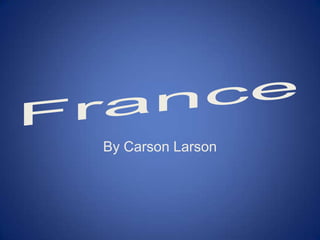
France
- 1. France By Carson Larson
- 2. Facts During the 17th and 18th centuries, France colonised great parts of North America; during the 19th and early 20th centuries, France built the second largest empire of the time, including large portions of North, West and Central Africa, Southeast Asia, and many Pacific Islands.
- 4. Culture France is home to people with various ethnic backgrounds including Celts, Romans, Germans, Russians, Asians, Africans North Americans and recent immigrations. The people of France are known worldwide for their sophisticated approach towards life, combined with great concern for style, fashion and appearances. France had been an important cultural center of the world for many centuries, with Paris being the cultural hub. Even today, France contributes greatly to the fashion culture of the world. Thereligionof France is predominantly Roman Catholic with anticlerical leanings. The French are extremely secular in nature and always prefer to make religion a private affair, separating its from politics. France guarantees freedom of religion as a constitutional right to all its citizens and the government is bound to respect this right in practice.
- 5. Beach
- 6. Flag FRANCE - NATIONAL FLAGThe national flag of France is known as drapeautricolore, drapeaufrancais, drapeau bleu-blanc-rouge and le tricolore. In military parlance, the flag is called les couleurs, COLOURS OF THE FLAGBlue, White and Red are the three colors used on the national flag of France. Each color of the French flag combines different symbols. Blue is the color of Saint Martin. He was a rich Gallo-Roman officer, who ripped his blue coat with his sword in order to give one-half of it to a poor begging in the snow. So blue symbolizes the care and duty the rich had to help the poor. google_protectAndRun("ads_core.google_render_ad", google_handleError, google_render_ad);
- 7. Wild live
- 8. Government The government of the France is a semi-presidential system determined by the French Constitution of the fifth Republic. The nation declares itself to be an "indivisible, secular, democratic, and social[clarification needed]Republic". The constitution provides for a separation of powers and proclaims France's "attachment to the Rights of Man and the principles of national sovereignty as defined by the Declaration of 1789." The national government of France is divided into an executive, a legislative and a judicial branch. The President shares executive power with his or her appointee, the Prime Minister. The cabinet globally, including the Prime Minister, can be revoked by the National Assembly, the lower house of Parliament, through a "censure motion"; this ensures that the Prime Minister is always supported by a majority of the houses.
- 9. Palace
- 10. History The history of France goes back to the arrival of the earliest human being in what is now France. Members of the genus Homo entered the area hundreds of thousands to years years ago, while the first modern Homo sapiens, the Cro-Magnons, arrived around 2 A number of important archaeological sites have been discovered in the country, testifying to continuous habitation by modern humans from the Upper Palaeolithic. According to John T. Koch and others, France in the Late Bronze Age was part of a maritime trading-networked culture called the Atlantic Bronze Age that also included Ireland, Britain, Spain and Portugal where Celtic languages developed.[1][2][3][4][5][6][7]
- 11. Hotel
- 12. Food French cuisine is extremely diverse, with only the Chinese having similar variety in their food. This variety is supported by the French passion for good food in all its forms, France's extraordinary range of different geographies and climates which support the local production of all types of ingredients, and France's long and varied history. In many ways, an understanding of the culture of French food and recipes is an understanding of France itself. Meals range from the very basic, such as the traditional baguette plus cheese plus inexpensive wine, to very elaborate affairs than can involve a dozen courses and different wines consumed over several hours. Obviously, the latter type of dining is exceptional for most people. However, it is this more sophisticated dining which is typically found in "French restaurants" outside France, giving many foreigners the mistaken impression that French food is heavy and complicated. In fact, much of the French cuisine is fairly simple, relying on high quality fresh ingredients and loving preparation rather than complex recipes.
- 13. Relaxing